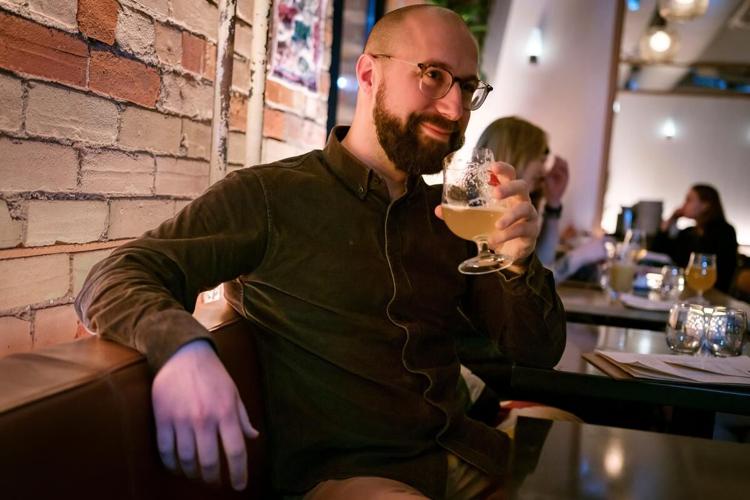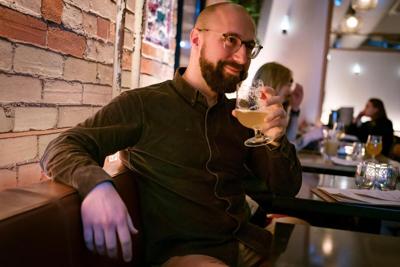ÔÇťThe body is a bit lighter, but itÔÇÖs not necessarily a bad thing,ÔÇŁ Dan Seljak says as he tries Bellwoods BreweryÔÇÖs . ÔÇťThereÔÇÖs a nice, bright citrus flavour, but itÔÇÖs complex. A first wave of citric, hoppy taste and then it gets more bitter.ÔÇŁ
His glass glows a pale orange-yellow every time he picks it up and the warm lighting shines through, making it pop against the otherwise dim dining room on a chilly Monday evening.
The self-professed indie beer fan quit drinking alcohol six years ago after deciding he was consuming too much of the stuff. He switched to seltzers and kombucha at home and stopped going to bars, but missed the social aspect of being able to nerd out on beer facts at a pub, like a coffee lover would at a local third-wave cafe.
Alcohol-free beer has long been an afterthought in beer circles, often a watered-down alternative that can taste more like second-rate swill than something that could be enjoyed on its own. But lately, the cityÔÇÖs craft brewers have been coming out with fantastic options to keep up with changing drinking patterns (the rising popularity of Dry January and CanadaÔÇÖs new alcohol guidelines, for example). On the larger scale, at last weekÔÇÖs Super Bowl, one of the most-watched television events every year with ads that are as anticipated as the game and halftime show.
The new non-alcoholic beers have the bitter and hoppy flavours of beer and, for people like Seljak, provide something less sugary than pop or juice to pair with food, letting him enjoy the social aspect of going out without having to consume alcohol.

Beer industry consultant Ren Navarro says changing drinking habits and breweries serving as multi-purpose spaces are among the reasons why there are more non-alcoholic beer options.
Ren NavarroÔÇťThereÔÇÖs Dry January, February and Sober October,ÔÇŁ Ren Navarro, a beer expert and consultant from ╔ź╔ź└▓, said. ÔÇťAnd beyond those three months there are people who canÔÇÖt drink because of allergies, recovery, doctorsÔÇÖ orders, a lot of reasons.
ÔÇťBreweries have already started coming out with lower (alcohol) percentage beers in the two per cent range, so why not make the jump and make a tasty, non-alcoholic product?ÔÇŁ she said, adding that she recently attended a sold-out class on making in Guelph.
Navarro notes that a number of factors have led to the rise of non-alcoholic beers in recent years (the beer with less than 0.5 per cent alcohol as non-alcoholic).
Alcohol sales have been dropping as people are now more mindful of their health, especially after the first year of the pandemic, when many overindulged on alcohol. Younger people have also developed a different relationship with alcohol than previous generations, she said, as self-care and the negative effects of alcohol are more openly discussed. Millennials and Gen Z still like to go out, but alcohol pays a smaller role in socializing.
The nature of breweries in the city is also changing, Navarro said, as many double as restaurants and event spaces, drawing a wider crowd that might not consume alcohol but is still willing to pay for a premium product thatÔÇÖs more interesting than a Coke.
Back at Bellwoods Brewery, Seljak tried another beer on tap, a booze-free version the bestselling fruity sour beer. He gave it a thumbs up.

Luke Pestl of Bellwoods Brewery pours out a non-alcoholic IPA called Stay Classy from the tap of his brewpub on Ossington Ave.
Giovanni CapriottiÔÇťItÔÇÖs one of our most challenging beers to produce,ÔÇŁ said co-founder Luke Pestl, explaining that it requires precise control over how much alcohol is produced during the fermentation process without losing flavour. ÔÇťIÔÇÖd say our non-alcoholic Jelly King is our favourite beer we produced last year, so we want it on the forefront.ÔÇŁ
A week earlier, he hosted BellwoodsÔÇÖ first non-alcoholic beer tasting at his brewery at 124 Ossington Ave., to showcase the new brews to customers and beer industry folk.
Elsewhere in the province, more non-alcoholic options have popped up. has a line of hop-flavoured sparkling waters; KingstonÔÇÖs brewery has one too; LeslievilleÔÇÖs . launched an alcohol-free IPA; and in Hamilton has non-alcoholic stout, IPA and pale ale in addition to seltzers. ╔ź╔ź└▓ÔÇÖs is perhaps the most widely known, popping up in supermarkets and restaurants.
To make non-alcoholic beer, you have to understand how beer is made. In a nutshell, beer is made by putting a grain, typically barley, through a process called malting, which involves soaking and heating it and forcing the grain to germinate. This allows the starch to be converted into sugar. Yeast is then added to feed on the sugar, creating alcohol and carbon dioxide as a byproduct.
For it to be booze-free, one of the older methods is boiling regular beer until all of the alcohol evaporates. Another method is through an expensive filtration and distillation process.
Bellwoods makes its non-alcoholic beer the same way as regular beer but, instead of boiling the alcohol out, the brewers adjust the fermentation process so the yeast doesnÔÇÖt produce enough alcohol to make it boozy. The challenge is maintaining the desired flavour and consistency that eluded earlier iterations of mass produced alcohol-free beers, which made them synonymous with a drink that tasted flat and one-note.
ÔÇťI always described it like someone ran water through a newspaper and poured it into a can,ÔÇŁ said Steve Abrams, who co-founded Mill Street Brewing back when it started in the Distillery District in 2002 (it was acquired by Labatt in 2015). ÔÇťIt was awful. It didnÔÇÖt have hop flavour. It was just a mess that you gave to someone whoÔÇÖs the designated driver or pregnant.ÔÇŁ
Abrams has since left Mill Street and, in 2021, launched a non-alcoholic, organic brewing company called with former Mill Street brewmaster and current Niagara College brewing instructor Rob Doyle, as well as Mike Cuch, who is in charge of marketing.

Harmon’s is a non-alcoholic, organic brewing company that was launched in 2021.
Harmon’sThe idea for ▒ß▓╣░¨│ż┤ă▓ďÔÇÖs started when Abrams was taking a break from alcohol consumption. Impressed by the non-alcoholic craft beer options while on vacation in California in 2019, he thought Ontario needed to catch up.
ÔÇťGlobally, Canada is a bit behind,ÔÇŁ said Cuch. ÔÇťIf you look at countries like Spain, Germany, Italy ÔÇö countries youÔÇÖd associate with high alcohol consumption ÔÇö thereÔÇÖs also high non-alcoholic beer consumption and you can see that with the large brewers. WeÔÇÖre seeing growth in those mature markets, which is the opposite of what youÔÇÖd see in a trendy drink.ÔÇŁ
With a relatively younger craft beer scene than its international counterparts, OntarioÔÇÖs brewers are still navigating what it takes to get their non-alcoholic beers onto shelves.
But whether the increasing popularity of non-alcoholic beers will lead to every craft brewery in the city making their own remains to be seen. For one thing, itÔÇÖs a costly and technical undertaking that could take years to perfect, and Pestl says many small breweries donÔÇÖt have the infrastructure and finances for that. Instead, heÔÇÖs been getting calls from breweries and restaurants that want to carry his non-alcoholic beer.
Beer consultant Navarro sees this as a permanent shift.
ÔÇťOver the last year, people are putting in real effort and there are companies that just do non-alcoholic beer,ÔÇŁ she said, noting that ▒ß▓╣░¨│ż┤ă▓ďÔÇÖs was started by craft beer heavyweights, and breweries have created separate companies focusing on seltzers and hop-flavoured waters. ÔÇťIn the past, a bartender would reach into a fridge to get a can of non-alcoholic beer, but now you can get it on tap and itÔÇÖs part of the permanent rotation.
ÔÇťAnd because the flavours are getting better, you can have non-alcoholic food pairings and get the same tasting notes as someone drinking something with alcohol. This also takes away the stigma (of not drinking) and the industry shows you can still have a good tasting beverage ÔÇŽ ThereÔÇÖs a shift in mentality.ÔÇŁ































To join the conversation set a first and last name in your user profile.
Sign in or register for free to join the Conversation